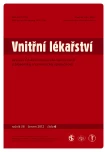Catheter ablation of atrio-ventricular accessory pathways in the era of ablation therapy of complex arrhythmias: a changing perspective for oncoming generation of electrophysiologists
Authors:
M. Fiala; J. Chovančík; D. Wojnarová; H. Szymeczek; J. Pindor; V. Bulková; R. Neuwirth; O. Jiravský; D. Vavřík; Š. Krawiec; J. Januška
Authors‘ workplace:
Oddělení kardiologie Nemocnice Podlesí, a. s., Třinec, přednosta prim. MUDr. Marian Branny
Published in:
Vnitř Lék 2012; 58(6): 434-438
Category:
Original Contributions
Overview
Introduction:
Catheter ablation of atrio-ventricular accessory pathways has become a routine treatment method. However, its perspective has been changing in the era of ablation of complex arrhythmias. This study was aimed at evaluating accessory pathways ablation efficacy within the last nine years at one center.
Methods:
From February 2002 to June 2011, catheter ablation of accessory pathways was performed in 247 patients (100 females, 42 ± 16 years). Elimination of accessory pathways conduction in both directions was the procedure endpoint.
Results:
Immediate accessory pathways conduction elimination at the first ablation was achieved in 228 (92%) patients. Ablation failed to eliminate accessory pathways conduction in 19 (8%) patients, or accessory pathways conduction subsequently recurred in another 7 (3%) patients. Repeat ablation was completed in 20 (8%) patients, 2 patients underwent a third ablation procedure. In total, accessory pathway was permanently eliminated in 238 (96%) patients. Ablation failure was connected with a risky position in the vicinity of atrio-ventricular conduction system in 6 (67 %) out of 9 patients. By the individual A, B, C, D operators’ experience, efficacy of the first procedure/total efficacy, was 97%/99%, 90%/96%, 87%/87%, and 91%/91%, respectively (comparison of inter-operator efficacy of the first and repeat ablation by Kruskal-Wallis ANOVA test: p = 0,19 and 0,05, respectively).
Conclusion:
Accessory pathways ablation efficacy exceeds 95%, and ablation failure is dominantly related to the accessory pathways location close to the atrio-ventricular conduction system. Individual operator’s experience was associated with a certain disparity between high and nearly absolute accessory pathways ablation efficacy.
Key words:
catheter ablation – accessory pathways – outcomes
Sources
1. Dagres N, Clague JR, Kottkamp H et al. Radiofrequency catheter ablation of accessory pathways: Outcome and use of antiarrhythmic drugs during follow-up. Eur Heart J 1999; 20: 1826–1832.
2. Calkins H, Yong P, Miller JM et al. Catheter ablation of accessory pathways, atrioventricular nodal reentrant tachycardia, and the atrioventricular junction: Final results of a prospective, multicenter clinical trial. The Atakr Multicenter Investigators Group. Circulation 1999; 99: 262–270.
3. Kay GN, Epstein AE, Dailey SM et al. Role of radiofrequency ablation in the management of supraventricular arrhythmias. Experience in 760 consecutive patients. J Cardiovascular Electrophysiol 1993; 4: 371–389.
4. Kobza R, Kottakmp H, Piorkowski C et al. Radiofrequency ablation of accessory pathways: contemporary success rate and complications in 323 patients. Z Kardiol 2005; 94: 193–199.
5. Cosío FG, Anderson RH, Kuck KH et al. Living anatomy of the atrioventricular junctions: A guide to electrophysiologic mapping. A Consensus Statement from the Cardiac Nomenclature Study Group, Working Group of Arrhythmias, European Society of Cardiology, and the Task Force on Cardiac Nomenclature from NASPE. Circulation 1999; 100: e31–e37.
Labels
Diabetology Endocrinology Internal medicineArticle was published in
Internal Medicine

2012 Issue 6
Most read in this issue
- Teleangiectasia hereditaria haemorrhagica –Osler-Weber-Rendu syndrome. Case study and treatment experience
- Disturbances of hemostasis in sepsis
- Cladribine is highly effective in the treatment of Langerhans cell histiocytosis and rare histiocytic disorders of the juvenile xanthogranuloma group
- An effect of continuous and intermittent renal replacement therapy on antibiotic treatment in critically ill patients with sepsis – a practice-based perspective of vancomycin and gentamycin therapies
